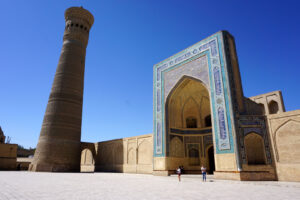Uzbekistan: in the footsteps of Marco Polo
Uzbekistan is the cultural heart of Central Asia for many travellers. This is the place where the ancient cities and architecture recall the magical time of the Silk Road. Visit cities such as Samarkand, Bukhara and Xiva and see impressive mosques, madrassas and mausoleums. Uzbekistan has been catching up with tourism in recent years. The Uzbek visa used to be known as a difficult one to get. Fortunately, that has changed since the presidential change in 2016. The visa is a lot easier to obtain and the country is increasingly opening up to tourists. And rightly so, we think. View our range of individual trips, and choose the ideal trip for you.
Uzbekistan
Name: Republic of Uzbekistan
Capital: Tashkent
Population: 40 million
Surface area: 447,400 km²
Language: Uzbek
Neighbouring countries: Kazakhstan, Kyrgyzstan, Tajikistan, Afghanistan, Turkmenistan






I’ve had the pleasure of travelling with CultureRoad on multiple occasions over a few years now and have always had amazing experiences. Especially Uzbekistan was a country to never forget.
nicole armfield (australia)
Samarkand
The most famous city of Uzbekistan is of course Samarkand. It is the most important city along the Silk Road and still has a magical attraction for many. In Samarkand there is much more to discover besides the world famous Registan. Places like Gur-e-Amir, the Bibi-Khanym Mosque and Shah–Zinda serve as key highlights of a trip through Uzbekistan.
Bukhara and Xiva
Besides Samarkand, Bukhara and Xiva are also worth a visit. With the beautiful old city centres you sometimes imagine yourself back in the time of Marco Polo’s travels. In Bukhara, for example, you will find ancient madrassas. And in Xiva the old high mud walls around the old centre are very impressive to see.
Tashkent
If you prefer the modern side of Uzbekistan, you should definitely visit the capital Tashkent. In contrast to the old cities, there is a lot of new construction and Soviet architecture to be seen here. For many people a welcome change after the old cities. The Tashkent metro is equally impressive, one of the deepest and most beautiful in the world.
Aral Sea
Almost everyone knows the story of the disappearing Aral Sea. A hundred years ago, it was one of the largest lakes in the world. In the meantime, only a fraction of the water surface remains. Since the 1960s, the lake has dried up at a rapid rate due to the irrigation of cotton cultivation in the area. During a visit to the Aral Sea, you’ll see what this means for the locals. It used to be busy with fishing boats, nowadays they are all dry in the sand.
The history of Uzbekistan differs from other Central Asian countries. Where Turkmens and Kirgizia well into the 19th century had a nomadic existence, Uzbeks lived mainly in towns and villages.
Domination and prosperity
In the 6th century, the Turks also brought Islam along with the language. In the centuries that followed, the region was conquered by various rulers such as Djenghis Khan, Timur and other Mongol tribes. Timur in particular left a big mark on the region. Under his leadership, Samarkand became a vibrant Islamic city.
Russia conquers Uzbekistan
In the early 18th century, Russian influence in Central Asia grew. Sometimes sought after, but usually very against the wishes of the local rulers. After the Russian Revolution of 1917, the contours of present-day Uzbekistan became increasingly visible.
Although the country became part of the Soviet Union, it managed to break away after 1991 and continue independently. The country’s first president became Islam Karimov.
Russia conquers Uzbekistan
Karimov held Uzbekistan in an iron grip for more than 25 years. The new president, Shavkat Mirzijoev, slowly started reforms after Karimov’s death in 2016. This meant a significant change for Uzbekistan and the promotion of tourism in the country.